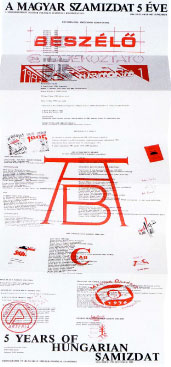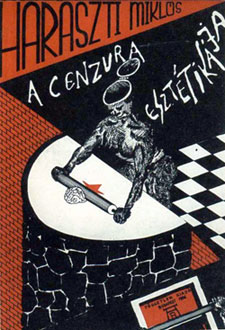A brief history of Hungarian samizdat
I have made use of the relevant parts of the historical overview published by Ferenc Kőszeg as an “Editor’s Note” in Roundtable. Digest of the Independent Hungarian Press, 1987/1&2, 3-5.
“The Russian word samizdat literally means self-publishing. It is meaningless in a world without censorship. But in countries where the government retains the right to control the publication of books, periodicals and articles, anything that is published and distributed without the censor’s stamp is samizdat. Censorship and samizdat depend on each other: while censorship exists, uncensored writing will always be circulated.” So wrote Ferenc Kőszeg, founding editor of Beszélö (Talker), the most influential Hungarian samizdat periodical launched in late-1981.
What I aim to do here is to provide a brief historical overview and an analysis of some of the passionate debates on censorship in Hungary during the 1980s. It was a hot topic in the dying years of the communist regime under Gorbachev, and remains widely debated today as an inherent part of the moral, political and intellectual heritage of the Hungarian democratic movement. Some of the samizdat written then has the capacity to stir people to action even now: A cenzúra esztétikája (The Aesthetics of Censorship) by a young journalist, Miklós Haraszti, has recently become popular in its Chinese translation among students and intellectuals in China.
The word samizdat became familiar in the Hungarian language along with knowledge of the Russian and Polish practice of clandestine, uncensored printing, publication and distribution of banned and dissident work. It was also used to refer to the works themselves and flourished in Hungary from 1977.
But the phenomenon had existed in Hungary well before this and ferocious state terror against any expression of dissent was practised from the early-1950s. The best Hungarian writers were reduced to silence, but their poems and writings circulating among friends. During this period, a considerable amount of religious material was also distributed among the followers of various denominations. After the Revolution of 1956 (also known as the Hungarian Uprising ed.) dozens of political manifestos, statements and essays were circulated among intellectuals, workers and students. If caught by the police, their authors served years in prison. A case in point is that of István Bibó, a member of the Revolutionary Government and an outstanding political thinker.
In the 1970s, samizdat editors produced some 170 publications, mostly typewritten and reproduced via carbon paper or by cyclostyle. The first, and one of the most important, was Marxizmus a negyedik évtizedben (Marxism in the Fourth Decade). Another, the 800-page Profil edited by János Kenedi, was a superb collection of poems, short stories, essays and studies rejected by official periodicals in the 1970s under the pretext that they did not fit the scope of the papers. The most significant early samizdat venture was the publication of the 1,000-page, three-volume Bibó-emlékkönyv (Bibó Memorial Book) edited by Ferenc Donáth and others, in honour of István Bibó. Bibó’s analysis of Hungarian society and his theories on “principled compromises” are strikingly similar to the Polish KOR’s (Committee for Self-Defence) conception of limited revolution and have strongly influenced Hungarian intellectuals.
Two periodicals were also published in this period. Magyar Figyelö (Hungarian Observer) concentrated on domestic affairs and on the fate of Hungarian national minorities beyond Hungary’s borders. Kelet-Európai Figyelö (East European Observer) mainly published translations from the samizdat and emigré press (tamizdat) of Soviet bloc countries.
In 1981, influenced by the enormous independent press in Poland at the time of Solidarity, various groups undertook the production of samizdat for wider circulation. The first mechanically duplicated publication was the fifth issue of Kelet-Európai Figyelö, published in August 1981, under the title A lengyel nyár (The Polish Summer).
Jaruzelski’s coup deeply shocked the Hungarian opposition and many gave up active participation. Most of the dissidents, however, decided to carry on. While two of the early periodicals, Kisúgó (Outformer – as opposed to Informer) and Magyar Figyelö ceased publication. The political quarterly Beszélö (while the word means “Talker”, it also refers to the visiting hours in prison) survived.
Together with the publication of the first samizdat reviews, book publication began. The first and most productive independent publisher was Gábor Demszky’s AB Független Kiadó (AB Independent Publisher), which began in 1982. Besides its series of political publications – Supplement to the History of Eastern Europe, 1956, Poland, Gulag – it published a growing number of works by foreign authors and Hungarian writers living at home or abroad. They published Orwell’s Animal Farm, plays by Vaclav Havel and novels by Milan Kundera. One of its most popular ventures was the publication of the autobiographical novel by György Faludy, the prominent Hungarian writer and poet. The 600-page novel Pokolbeli víg napjaim (My Jolly Days in Hell), which had previously been published in English, French, German, Swedish and Japanese, appeared for the first time in Hungarian as a samizdat book.
Another independent publisher, Jenö Nagy’s ABC Press brought out Arthur Koestler’s Darkness at Noon and the biography of Raoul Wallenberg. The publishers under the name M.O. Független Kiadó (Hungarian October) launched by the intransigent 56-er György Krassó, considered their main task to be the publication of works and documents connected to the 1956 Revolution. Among them are books such as Bibó’s writings from 1956 and Hungarian Diary by Wiktor Woroszylkski, the eminent Polish poet and journalist. They also issued the striking autobiographical writing of Béla Szász, a survivor of the Rajk trial [László Rajk, a communist politician was accused of being a “Titoist spy” and executed in 1949 ed.] and George Orwell’s 1984.
 Several smaller publishers also played an active part in independent publishing. These included Áramlat (Stream), Katalizátor Iroda (Catalization Bureau), Alulnézet (Bottom View) and Szabadidö (Leisure Time). Special mention must be made of the avant-garde artistic publications and political documents used as art objects by the Inconnu Art Group. Although Hungarian censorship was relatively liberal compared to that in other Soviet bloc countries, the works listed above would never have reached the Hungarian public without the independent publishing houses.
Several smaller publishers also played an active part in independent publishing. These included Áramlat (Stream), Katalizátor Iroda (Catalization Bureau), Alulnézet (Bottom View) and Szabadidö (Leisure Time). Special mention must be made of the avant-garde artistic publications and political documents used as art objects by the Inconnu Art Group. Although Hungarian censorship was relatively liberal compared to that in other Soviet bloc countries, the works listed above would never have reached the Hungarian public without the independent publishing houses.
A few titles among the many Hungarian samizdat periodicals are well worth mentioning, among them Beszélö, already mentioned, Máshonnan Beszélö (Talker from Elsewhere), AB Hírmondó (AB Messenger), Demokrata (Democrat), Égtájak között (Beyond Points of the Compass), Vízjel (Watermark), Magyar Zsidó (Hungarian Jew) and Határ/idö/napló – erdélyi figyelö (H/I/N Transylvanian Monitor). The techniques generally used included mimeography, silk screen printing, ramka (from the early days of Polish samizdat and a combination of the previous two techniques), photocopying and offset printing. The latter was widely used in book publishing from the mid-1980s.
By 1988, radical opposition movements had gathered momentum, the organisation of democratic proto-parties had started and it became impossible to stop the sudden boom in independent publications. It was no more than a public admission of the political reality when, in May 1989, the last communist prime minister Miklós Német declared that prior permission for publishing books and newspapers of any kind was no longer required. This was the official end of a censorship which had been in existence for more than four decades alongside the forcibly prolonged communist rule of the country.
All in all, in just over a decade, 1977-1989, the Hungarian samizdat movement produced some 300 books and two dozen periodicals. This crop might not seem as rich and versatile as the Soviet Russian one, and certainly had far less “mobilizing power” than the independent Polish press had for many years by supporting the resistance of a whole society against communist rule and its military regime. Yet two of its particular merits seem still significant: its intellectual force and radical engagement with truth and justice. These can be most clearly felt in the arguments of the onetime debates on censorship both in samizdat publications and in other free forums such as the public debates of the Alternative Cultural Forum of 1985 and the Hungarian Writers’ Association.
Inside and outside the “Velvet Prison”
“In Hungary there is no censorship,” declared György Aczél, cultural secretary of the Central Committee of the Communist Party for more than two decades in an interview with Paul Lendvai in 1980. However, everyone was well aware of the fact that in a country of “existing socialism” such a thing as censorship all too evidently did exist. The statement made by the most influential communist leader in charge of cultural policy was nothing but a routine propaganda lie, or another sample of Orwellian “doublespeak”.
The state bureaucracy and the Politbureau repeatedly discussed how to treat the “oppositional-hostile groups” and their “illegal publications”, yet principles were never declared publicly, nor was a list of banned works or writers ever published, although it was loudly demanded from time to time by the rebellious editors of Mozgó Világ, for example, or at the assemblies of the Hungarian Writers’ Association in the 1980s. Informality in the daily practice of administration remained paramount in the later years of János Kádár’s government.
Needless to say, the “Thought Police” played a mighty role too, especially Department III/3 of the State Security Corps. House searches, short-term arrests, heavy fines and various other forms of harassment occurred regularly from 1981 until 1988. All in all, thousands of copies of samizdat books and newspapers were destroyed, and a number of duplication machines were confiscated. During the early years of samizdat, from 1982 to 1984, the editors of the periodicals Beszélö and Hírmondó were repeatedly harassed and fined. In spring 1983, Gábor Demszky, editor in chief of AB publishers was attacked by the police in the street and, under the pretext of violence against the authorities, given a six months suspended sentence. Somewhat later, it was György Krassó, the publisher of Hungarian October and the editors of Democrat, Beyond the Points of the Compass and Catalizator Office who suffered serious harassment, repeated house searches, and were forced to pay massive fines.
 The first conceptual samizdat work to mount a daring attack on state censorship was the pamphlet by Miklós Haraszti originally entitled A cenzúra esztétikája (The Aesthetics of Censorship), or in its later English language version The Velvet Prison. Haraszti’s critical view of censorship practises was formed some years earlier in the mid-1970s, when the so-called Kádárist consolidation in the wake of 1956, with its routine-like institutional control on culture, science and education was still felt strongly in Hungary. In addition, most of the artists, writers and state-employed intelligentsia seemed not merely to respect the rules of the communist regime but to willingly support them. This kind of loyalism as a general attitude led Haraszti to conclude that some two decades after 1956, those in charge of the daily practise of censorship had successfully handed on much of their function in the form of self-censorship to the artists and intellectuals themselves. As he saw it, this had become the major challenge in a new system of state control of cultural and intellectual life: in short, a “new civilisation” was emerging.
The first conceptual samizdat work to mount a daring attack on state censorship was the pamphlet by Miklós Haraszti originally entitled A cenzúra esztétikája (The Aesthetics of Censorship), or in its later English language version The Velvet Prison. Haraszti’s critical view of censorship practises was formed some years earlier in the mid-1970s, when the so-called Kádárist consolidation in the wake of 1956, with its routine-like institutional control on culture, science and education was still felt strongly in Hungary. In addition, most of the artists, writers and state-employed intelligentsia seemed not merely to respect the rules of the communist regime but to willingly support them. This kind of loyalism as a general attitude led Haraszti to conclude that some two decades after 1956, those in charge of the daily practise of censorship had successfully handed on much of their function in the form of self-censorship to the artists and intellectuals themselves. As he saw it, this had become the major challenge in a new system of state control of cultural and intellectual life: in short, a “new civilisation” was emerging.
Censorship is no longer a matter of simple state invention. A new aesthetic culture has emerged in which censors and artists alike are entangled in a mutual embrace … This book is intended to be neither a sad collection of anecdotes of the censored nor an academic analysis of an evil system of surveillance. These two approaches, which tend to be favoured by specialists on Eastern Europe, succeed only in evading the more important questions. Who makes this culture? Why? How? Why is it so durable? Is the presence of overt or covert terror a sufficient reason for its survival? Is freedom really necessary for art to flourish?
Even these questions reflect the fact that Haraszti, often with heavy irony, willingly took on the role of devil’s advocate. However, his historical remarks on freedom of thought and freedom of art seem more essential and worth consideration.
Only since the middle of the last century has art be seen as synonymous with anti-authoritarianism. Only then did art become the recognized symbol of the protest of the individual consciousness, questioning the order of the world. That artistic autonomy could be an end in itself was part of the promise of bourgeois civilization. But the period in which this promise was made spans only a fraction of the history of art … But I think that perhaps memory is short. Sinologists particularly relish the discovery of irony, satire, and irreverence in the poetry of millennia of empire which had seemed initially to have nothing but praise for the emperor. In the Middle Ages, too, did not heretics reinterpret accepted dogmas, and were they not condemned, until their views were later accepted? Surely I have no reason to consider totalitarian socialism’s double talk any more destructive or short-lived than that of its predecessors.
Communication between the lines already dominates our directed culture. This technique is not the speciality of the artist only. Bureaucrats, too, speak between the lines: they, too, apply self-censorship. Even the most loyal subject must wear bifocals to read between the lines: this is in fact the only way to decipher the real structure of our culture. Real communication takes place only between the lines. And it is public life itself that is the space between the lines.
But what fun could such a perverted communication offer those who take part in it? Haraszti finally gives a masterly answer in which empathy and irony are well mixed:
The reader must not think that we detest the perversity of this hidden public life and that we participate in it because we are forced to. On the contrary, the technique of the writing between the lines is, for us, identical with artistic techniques. It is a part of our skill and a test of our professionalism. Even the prestige accorded to us by officialdom is partly predicated on our talent for talking between the lines. What is unsaid is at least as important as (and often more important than) what is said.
Haraszti’s book had a lively reception both in Hungary and worldwide. It was published as a cyclostyled samizdat brochure in Budapest in 1981, not long before martial law was introduced in Poland. Another Hungarian samizdat version in book form was published in 1985, and French, German and English translations came out during the 1980s, as well as a clandestine Canton Chines version printed recently in Hong Kong.
Haraszti’s pamphlet was much influenced by the theory György Konrád and Iván Szelényi offered in Intellectuals on the Road to Class Power, a book also originally published in samizdat. Since communism or state socialism was officially declared to be a system based – at least in theory – on unquestionable Marxist doctrine, all its opponents felt themselves challenged to express their critical views on a structured theoretical basis. As Konrad comments in his forward to the English version of Haraszti’s book:
Previously, in a book entitled Intellectuals on the Road to Class Power, written with Ivan Szelényi, I tried to examine how the intelligentsia was becoming a separate class in state socialism. The theory that in state socialism censorship is an inherent part, a constitutional and constructive element of literature, gradually expropriated by the elite in power, was in fact inspired by the mood of the mid-1970s. We came to the realization that communism is a system whose power is sustained not by the police alone.
Haraszti’s pamphlet also provoked critical reflections among Hungarian writers and intellectuals. Two of them, poet and philosopher György Petri and historian Gábor Klaniczay, published their comments in Beszélö, the most influential Hungarian samizdat periodical. Petri radically rejected Haraszti’s concept and his description of a “new civilization” based on mutual self-restraint on the part of both the subject and the rulers. He categorically denied that censorship of any kind ever had any inspiriting impact on culture, nor was he ready to accept that writers and intellectuals could ever benefit from or creatively contribute to such a compromise. On the contrary, he witnessed more and more promising efforts for intellectual autonomy on the basis of the re-establishment of some moral principals and professional standards of intellectual life. Meanwhile, the censorial practice of state socialism had lost any authentic ideological principals, and displayed nothing but the real repressive nature of a police state.
In his article, Klaniczay reflectes on both Haraszti’s and Petri’s arguments. In the first place, “Haraszti and Petri did not seem to talk about the same thing” and both tend to neglect the real nature of culture. However, he readily admits “the positive function of Haraszti’s satirical-pessimistic overstatements”, in as much they successfully inspire critical thinking and provoke some counter arguments. As Klaniczay also notes, Haraszti’s bad luck is that his pamphlet came out too late and much of his vision of the flourishing “new civilization” of post-Stalinist consensus on self-censorship had became obsolete in the interim: “Today I would rather agree with Petri’s views, than Haraszti’s vision.”
However, as Klaniczay added:
Haraszti’s book, to my knowledge, is the first overall effort to describe the new type of constraints and their potential output on the socialist culture as a system – and that deserves more than just an angry ejection … Petri should not have criticised Haraszti for the poetic overstatement of “a new civilization”, but rather should have pointed out that the system the author suggested is a very static one.
Culture in a broader sense is the daily practice of a society that can neither be directed by cynical, counter-selective bureaucrats, nor be based only on the heroic resistance of some radical intellectuals; and that is what makes Klaniczay none too optimistic for the future.
Devoted documenters of “delphinology”
A sophisticated mechanism of state control also restricted free research and open debate, especially in the humanities and social sciences. This was intended to be counterbalanced somehow by private flat seminars, popularly known as the “flying university”, dedicated to hot issues of past and present. Even at that time there were some passionate “documenters” of censorial abuses and intellectual resistance. Historian Miklós Szabó, for example, gave an account on the past decades of Hungarian academic institutes, in which he also underlined the importance of the fact, that a relative autonomy here or there could be successfully preserved due to the hidden ongoing effect of the 1956 revolution. (Released from prison in the early 1960s, many of the ex-faculty, who had been engaged in the Revolution, managed to find asylum in some less tightly-controlled academic research institutes.) Another dissident, philosopher György Bence analysed the Communist Party’s ideological campaigns intended to restrain free research and open scientific debate. In his detailed study of 1985, literary editor Ferenc Kőszeg concludes that “censorship today strikes social science publications much more than belles lettres, and controls abstract ideas more strictly than empirical facts”. Although the opposite could be equally true in some cases – banned documentary films or unpublished research findings on poverty and corruption, or discrimination against the gypsies etc. – Kőszeg provides an interesting comparison:
The findings of a sociographical study that drinking-water is infectious in a good number of villages but the authorities seem not to care, are more likely to shake the trust of the average reader – in fact all normal human beings – in the blissful prophecies of Marxism-Leninism than the simple statement that Engels’ thesis on the “dialectics of nature” are either banal or nonsensical. Yet the former study can be published and the later cannot, since censorship of philosophical publications is still guarding and protecting the Doctrine that nobody takes seriously any longer.
Censorial control was extended to the literary and intellectual heritage of the country immediately after the communist takeover of 1948. Sometimes it was just a matter of changing a few words or names, omitting a few lines for “ideological” reasons; in other cases complete novels, stories, memoirs or poems were left out from the “collected works” of nineteenth- and twentieth-century national classics. This shameful practice outraged many independent-minded authors and editors, who systematically documented these “philological abuses” and made them public, either in official or samizdat papers and in regular or “flying” seminars. The most dedicated defenders of Hungarian classics who fell victim opposing this posthumous censorship were Mátyás Domokos, László Szörényi, Péter Balassa, Ákos Szilágyi and Ferenc Kőszeg. As a result, by the early-1980s protecting the national classics from the hands of the communist censors became an intellectual fashion known by the ironic term “delphinology”. This witty invention of the young literary historian László Szörényi, reflected the late mediaeval practice of the French Jesuits, who systematically censored the works of antique authors for the use of the Dauphin, the young heir to the throne: “ad usu Delphini”.
Occasionally, as when issues of literary or cultural periodicals were confiscated and their disobedient editors suddenly replaced, scandals became noisily public. The founding editor of Beszélö, Sándor Szilágyi, analysed a number of such cases from the 1960s to the early-1980s in an article that describes the battle against censorship of such distinguished monthlies as Mozgó Világ, Filmkultúra, Kortárs, Forrás and Tiszatáj.
These cases were one of the main issues collectively raised and passionately debated by all authors at the general assemblies of the Hungarian Writers Association during the 1980s. Small wonder, since such periodicals traditionally had a high reputation as well as a special mission in shaping intellectual and public life in the country alongside the one and only literary weekly since 1957, Élet és Irodalom (Life and Literature), mostly read for its critical debates, daring reports and interviews.
The loudest of all these scandals was the replacement of the young and radical editorial staff of Mozgó Világ (Moving Word) in 1983. It was an open secret that this highly popular periodical had been taken over by a new generation of writers and editors and was engaged in a permanent conflict with Party apparatchiks and the censorship bureaucracy. The editors, who felt in fitting Marxist fashion they “had nothing to lose but their chains”, finally decided to refuse all informal instructions from above and openly turned to the public for support. They also insisted on receiving a detailed list of all banned authors and works from the censors, a demand that further infuriated the latter. In order to save the periodical and its editors, a large and semi-spontaneous solidarity campaign was launched. Protest letters were sent, public debates were held and demonstrations organised at Budapest universities. All in vain: the editorial staff finally had to leave. But it did provide a promising precedent: public protest could gain massive support and this was a sign that state censorship would not last too long.
Rebellion in the Hungarian Writers’ Association
The debates at two General Assemblies of the Hungarian Writers’ Association stand out among the many confrontations at this time: one was held in December 1981, the other in late-1986 – the thirtieth anniversary of the 1956 Revolution. The details of these legendary episodes remained “public mysteries” throughout the 1980s and most of the documents have since vanished. Had these debates not been published at the time in samizdat (Beszélö) and in tamizdat (Gazette Litteraire Hongroise in Paris and Radio Free Europe) little more than fragments would be left to recall them today.
One such is Farewell to the Writers’ Association by György Konrád. It accurately reflects the sinister atmosphere of late-1981:
Twenty-five years have passed [since the autumn of 1956] and I have not had much to do with the Hungarian Writers’ Association, but I did go to its General Assembly on 12 and 13 December 1981. On behalf of the Communist Party, or as it was commonly called in those days ‘the Power’, György Aczél gave a long speech in a somewhat threatening tone, but in the break he appeared to neglect all the neutral and flattering participants gathered around him and came to the three of us, his main opponents at that time: Sándor Csoóri, István Eörsi and me, to have some polemical chat.
We received the news on that very day that martial law had been introduced in Poland. The dirty job that had been done in Hungary in 1956 by the Soviet Army, was done in Poland by its own ‘national army’ under General Jaruzelski’s command. We formed our closed groups and the whole session of the General Assembly was dominated by the murmur of private discussions. Some participants here or there gathered around small radio sets to listen to the Hungarian channel of Radio Free Europe. In fact, the high-ranking Party apparatchiks seemed to feel as unsafe as the writers themselves, who were not fond of the noise of tanks and the early morning commandos sent out to make arrests.
In such circumstances, one might ask if there were any protests or real debates on the agenda of the 1981 General Assembly. In fact, on 12 December, just one day before the Polish military coup, István Eörsi protested openly against the administrative means used to restrict writers’ freedom. He spoke about secretly circulated prohibition lists, for which no one dared to take personal responsibility, and proposed replacing this practice with legally defined, overt censorship. Many must have felt silent sympathy for those who were present, yet the provocative proposal failed to gain support from other speakers. The only reaction was that of the editor-in-chief of Élet és Irodalom, who shouted cynically that he was ready to blue-pencil Eörsi’s writings any time, since he had acquired great experience in that particular job. Apart from this interlude the most radical signs of writers’ resistance were limited to some reform proposals aimed at changing the Association’s Charter and instituting more democratic procedures in the election of the Board.
The second day, 13 December, was overshadowed by the sinister news from Poland recalled in Konrád’s memoirs. Although some anxious speakers warned their intransigent colleagues “not to provoke the Power by their disobedience to the point of repeating the tragic conflict of 1956 or the imposition of a military dictatorship, which would send them into prisons”, no protest against the Polish military coup and no solidarity with Polish writers was declared by the Assembly.
At this point, we cannot proceed without being reminded, however briefly, of the major role Hungarian writers played in 1956. Many of them took an active part in public events before, during and after the Revolution, and the Writers’ Association itself was the first and last stronghold of national democratic resistance. Until Stalin’s death, literature and public life were supposed to serve communist propaganda under the direct control of the Party and the Hungarian division of the KGB.However, during the first government of Imre Nagy (1953-1955), a number of prominent writers and poets such as Tibor Déry, Gyula Illyés, Lörinc Szabó, Áron Tamási and László Németh, began to publish their works once more. Step by step, the Writers’ Association regained its autonomy and, along with the Petöfi Kör (Petofi Circle) and the Irodalmi Újság (Literary Gazette), became the most influential forum of public debate. During the “13 days that shook the Kremlin” writers expressed their whole-hearted support of the Revolution in every possible way: they published poems and articles in the free press, appealed to the world to aid Hungary, took part in a number of peaceful demonstrations and kept in touch with revolutionary bodies, students and workers, freedom fighters and the founders of new parties, thus helping to shape the countrywide unity of all democratic forces. Long after the Soviet invasion of 4 November, writers remained demonstrably loyal to the Revolution in the darkest days of terror and misery in a half-ruined country. This high-spirited patriotism and deep engagement with democratic ideas was felt in the last free assembly of the Writers’ Association held on 28 December 1956. Especially in its solemn declaration of “Trouble and Trust”, a text by the brilliant novelist Áron Tamási which may read as the moral and political testament of a crushed Revolution. Two weeks later, there were massive arrests among writers and the Association was forcibly dissolved.
It took three years to break the silent resistance of the writers and to restart the now “pacified” Association. But it took three decades for writers to revolt openly again, as they did at their 1986 gathering, and for the communist regime to confront them by force.
Of more than 600 members of the Association, 444 writers were present, including the 70 members of the elected board. Apart from the Minister of Culture and his deputies, two Secretaries of the Central Committee of the Party attended the meeting together with a number of powerful academics, heads of departments, publishing houses, editorial staff and countless lower level literary apparatchiks. On the other side a great variety of restless “irregular” troops gathered for the long-awaited clash supported by a mighty crowd of lone heroes ready to join them if needed.
In fact it was more a picturesque political battle than a decent discussion by distinguished men of letters. “What happened during the past five years cannot happen again.” The Secretary of the Central Committee, János Berecz, Kádár’s secret nominee as his successor, started his speech in a threatening tone. Though it had very different connotations for the two sides, this was probably the first and last statement that all present could fully agree on. While the speaker was expressing the Party line that it would no longer tolerate disobedience, most of the writers felt that arbitrary control of society by politicians must not be prolonged indefinitely. As the most popular speakers – Miklós Mészöly, Gábor Albert, István Eörsi and István Csurka – argued, the “nationwide consensus” was over and the country was facing a deepening crisis. Politicians were accusing writers of intervening in politics illegitimately and writers accusing politicians of intervening in literary affairs equally without legitimacy. Both parties were at breaking point, as was soon demonstrated by a number of events.
The final act on the second day of the Assembly was the election of a new Board. Elected under the amended procedures, it was dominated by the radicals; the Party scarcely figured. In response, some two dozen highly-placed members, including Béla Köpeczi, the Minister of Culture himself, flounced out of the meeting and began to form their counter-organisation. State finance of the “old one” was cut and rumours of its imminent dissolution spread. The counter-campaign was supported by gassizdat (the government press), but died out in a few weeks and, in the end, less then 5 per cent of its members remained. It proved to be a further loss of prestige for communist cultural policy and was not without its comic elements, notably the deeply offended high-ranking apparatchiks. After all, who could protect an almost omnipotent, but highly ungifted minister from himself?

 Several smaller publishers also played an active part in independent publishing. These included Áramlat (Stream), Katalizátor Iroda (Catalization Bureau), Alulnézet (Bottom View) and Szabadidö (Leisure Time). Special mention must be made of the avant-garde artistic publications and political documents used as art objects by the Inconnu Art Group. Although Hungarian censorship was relatively liberal compared to that in other Soviet bloc countries, the works listed above would never have reached the Hungarian public without the independent publishing houses.
Several smaller publishers also played an active part in independent publishing. These included Áramlat (Stream), Katalizátor Iroda (Catalization Bureau), Alulnézet (Bottom View) and Szabadidö (Leisure Time). Special mention must be made of the avant-garde artistic publications and political documents used as art objects by the Inconnu Art Group. Although Hungarian censorship was relatively liberal compared to that in other Soviet bloc countries, the works listed above would never have reached the Hungarian public without the independent publishing houses. The first conceptual samizdat work to mount a daring attack on state censorship was the pamphlet by Miklós Haraszti originally entitled A cenzúra esztétikája (The Aesthetics of Censorship),
The first conceptual samizdat work to mount a daring attack on state censorship was the pamphlet by Miklós Haraszti originally entitled A cenzúra esztétikája (The Aesthetics of Censorship),




